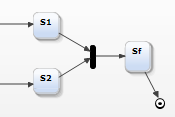Comparison of the graphical representation
The following table depicts a detailed comparison of the graphical representation between the KIELER SyncCharts Editor and the Yakindu SCT Editor.
| KIELER | YAKINDU |
|
|---|---|---|---|
Transition |
|
| YAKINDU: There is only one type for transitions KIELER: Strong Abort, Week Abort, Normal Termination |
State |
|
|
|
Composite State |
|
|
|
Initial State |
|
| YAKINDU: Initials State are pseudo states. The Initial State may not be a Composite State. An initial state can only have one outgoing transition and no incoming. KIELER: Initial states are supposed to have a thicker border than normal states |
Final State |
|
| YAKINDU: Final States are pseudo states. The Final State may not be a Composite State KIELER: Final states are depicted with a double border |
History |
|
| YAKINDU:
KIELER: A History is a attribute of a Transition |
Synchronization |
|
| YAKINDU: Synchronization is a pseudo state. KIELER: Synchronization not needed in KIELER
|
Choice |
|
|
|
| KIELER | YAKINDU |
|---|---|---|
Interface declaration |
|
|



















